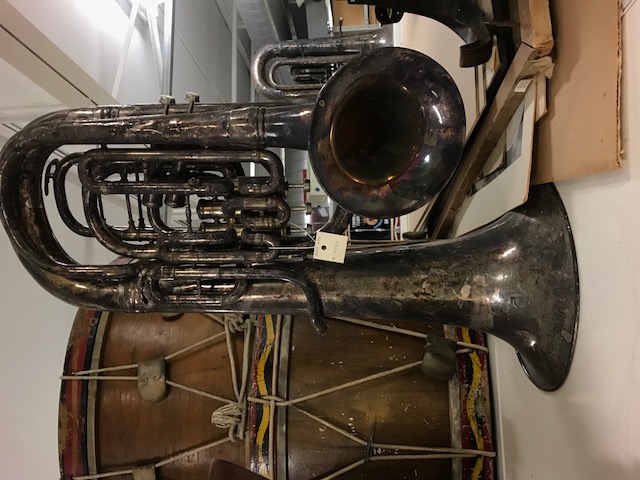Archives
-
Oct23Mon
Now I Know!
Retrospective #36 October 23, 2017 Randy C. Hicks Yes! This picture needs editing!
Yes! This picture needs editing!I knew full well that I had not discovered a new artifact; the folk who donated it knew about it; the people who received it knew about it; anyone visiting who happened to look up at the top of the cabinet likely knew about it; but for me it was new! Actually it was old but you know what I mean. I had never seen one of these before and didn’t immediately realize its makeup my first glance in its direction.
A couple of tarnished brass instruments from a band of yesteryear – part of a small collection held in our facility. I know we have a number of Cornets, a Horn, Trombone, Euphonium, Bass and one of these.
At first glance, as mentioned above, I thought I was seeing a Euphonium with a Horn placed immediately in front of it, or was it behind it? Thinking it might be my new glasses I decided to take a closer look. Climbing the ladder I discovered it was neither a traditional Euphonium nor a common Horn.
What was it?
This instrument had two bells!
A Euphonium Bell and a Horn Bell!
One instrument with two bells!?
Was it a “Euph-Hornium?”
Maybe a “Horn-Euphium?”
I excitedly took a snapshot and sent it to a couple of Music-Teacher friends expecting to surprise them as I had been surprised. Not gonna happen! Each of them in turn, with an expression of “what are you – stupid?” air about them, calmly responded “Oh, that’s a Double Bell Euphonium!” (I like my names better!)
Who knew? (Ok, everyone but me!)
So, I Googled it!
1. “The double bell euphonium is an instrument based on the euphonium. The larger bell produces the mellow tone of a standard euphonium; the second smaller bell has a brighter tone, similar to a baritone horn or valve trombone. The instrument is sometimes dismissed as a novelty, but has had a small number of enthusiastic adherents, although few professional musicians use it as their sole or primary instrument. The smaller bell can give more appropriate tone in the higher range of the instrument. The two bells can also be used for special effects, such as echoes, and using the distinctly different tone of the two bells for a single musician to give the effect of call and response…
2. The double bell variation of the euphonium was mass-produced starting in the 1880s, first produced by the C.G. Conn Company, in the United States. Other major U.S. brass instrument makers followed suit. The instrument was first popularized by euphonium virtuoso Harry Whittier with the famous Patrick Gilmore band starting in 1888; the John Philip Sousa band added the instrument the following year, with other US brass bands following the example. Peak production of the instrument was from about the 1890s into the 1920s, although it was never one of the more popular brass instruments...
3. The last double bell euphoniums were made around 1960. In practice, most double bell models ended up being used with the large bell only, effectively a very heavy single bell euphonium. About the second bell, famous euphonium soloist Arthur W. Lehman once said during a Marine Band concert, "We use it to hold our white gloves when we are not wearing them."”
The DBE that we have was made by the C.G. Conn Company (referred to above) and came our way from the former West Toronto Corps.
Now I know!





Leave a Comment